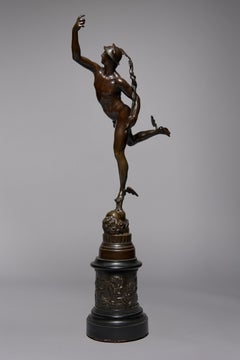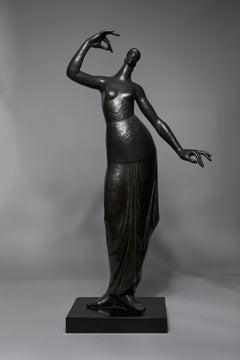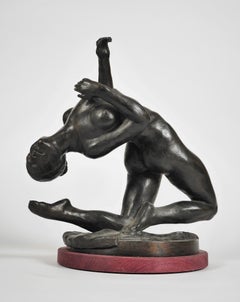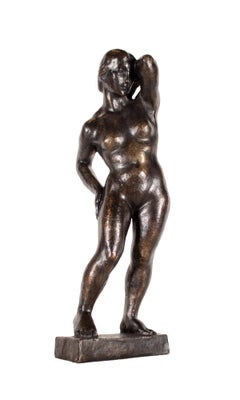Video Loading
Want more images or videos?
Request additional images or videos from the seller
1 of 9
UnknownLate 18th Century Bronze Sculpture after the Farnese Hercules
Price:$3,000
$3,500List Price
About the Item
- Dimensions:Height: 16 in (40.64 cm)Width: 6.4 in (16.26 cm)Depth: 4 in (10.16 cm)
- Medium:
- Period:
- Condition:
- Gallery Location:Beachwood, OH
- Reference Number:1stDibs: LU1768213609022
About the Seller
5.0
Platinum Seller
Premium sellers with a 4.7+ rating and 24-hour response times
Established in 1975
1stDibs seller since 2022
41 sales on 1stDibs
Typical response time: 1 hour
Authenticity Guarantee
In the unlikely event there’s an issue with an item’s authenticity, contact us within 1 year for a full refund. DetailsMoney-Back Guarantee
If your item is not as described, is damaged in transit, or does not arrive, contact us within 7 days for a full refund. Details24-Hour Cancellation
You have a 24-hour grace period in which to reconsider your purchase, with no questions asked.Vetted Professional Sellers
Our world-class sellers must adhere to strict standards for service and quality, maintaining the integrity of our listings.Price-Match Guarantee
If you find that a seller listed the same item for a lower price elsewhere, we’ll match it.Trusted Global Delivery
Our best-in-class carrier network provides specialized shipping options worldwide, including custom delivery.You May Also Like
1961 Coty Award Plaque Kenneth Hairdresser Jacqueline Onassis Bronze Fashion
Located in New York, NY
1961 Coty Award Plaque Kenneth Hairdresser Jacqueline Onassis Bronze Fashion
Bronze on wood. The wood plaque measures 12 3/4" by 20 3/4 inches. The bronze plaque itself is 13 3/4 x 8 3/4 inches and the the bronze inscription, which reads "COTY, American Fashion Critics Special Award 1961 to KENNETH of LILY DACHE...
Category
1960s American Modern Figurative Sculptures
Materials
Bronze
Sydney Kumalo Bronze Minimalist African Modernist Sculpture Figural Female Nude
Located in Surfside, FL
Sydney Kumalo. Features a bronze stylized female figural form sculpture fixed to a marble plinth and wood base. Bears signature on base. Measures 9 1/2" x 4 1/4". There is no edition number on the piece.
Sydney Kumalo (1935 - 1988) was born in Sophiatown, Johannesburg, on 13 April 1935. His was one of the families who had to move out of the "white" city to the South Western Townships, or Soweto. Raised in Diepkloof and educated at Madibane High School, he took with him from old Sophiatown the curious and diverse heritage of its heyday. Art classes in the Catholic school, "Sof' town" blues and jazz, the vibrant street culture and growing defiance of its population of various races who were gradually forced out into separate race-group areas. So it was that these various aspects of his early life created for Kumalo a cultural mix of a Zulu family related to the traditional royal house; city schooling, nascent township music and lingo; growing urbanised political defiance and the deep-rooted Zulu pride and respect for the legends and ancient stories of a tribal people. This mix of old and new cultures was reinforced when he began his studies at the Polly Street Art Centre in 1953 where he became a member of Cecil Skotnes group of serious artists who were encouraged to acquire professional skills. Skotnes introduced a basic training programme with modelling as a component, which marked the introduction of sculpting (in brick-clay) at Polly Street.
Kumalo was Skotnes’ assistant at Polly Street from 1957 to 1964, and having recognised his great talent as a sculptor, Skotnes encouraged him to become a professional artist.
After Kumalo’s very successful assistance with a commission to decorate the St Peter Claver church at Seeisoville near Kroonstad, with painting designs, sculpture and relief panels in 1957, Skotnes arranged for Kumalo to continue his art training by working in Edoardo Villa ’s studio from 1958 to 1960. Working with Villa, he received professional guidance and began to familiarize himself with the technical aspects of sculpting and bronze casting. In 1960 he became an instructor at the Polly Street Art Centre.
Kumalo started exhibiting his work with some of the leading commercial Johannesburg galleries in 1958, and had his first solo exhibition with the Egon Guenther Gallery in 1962. He was a leader of the generation who managed to leave behind the forms of African curios, reject the European-held paternalism which encouraged notions of "naive" and "tribal" African art, and yet still hold fast to the core of the old legends and spiritual values of his people. He introduced these subjects into his bronze sculptures and pastel drawings, evolving his own expressive, contemporary African "style".
Together with Skotnes, Villa, Cecily Sash and Giuseppe Cattaneo, Kumalo became part of the Amadlozi group in 1963. This was a group of artists promoted by the African art collector and gallery director Egon Guenther, and characterised by their exploration of an African idiom in their art. Elza Miles writes that Cecil Skotnes’ friendship with Egon Guenther had a seminal influence on the aspirant artists of Polly Street: “Guenther broadened their experience by introducing them to German Expressionism as well as the sculptural traditions of West and Central Africa. He familiarised them with the work of Ernst Barlach, Käthe Kollwitz, Gustav Seitz, Willi Baumeister and Rudolf Sharf.” It is therefore not surprising that some of Kumalo’s sculptures show an affinity with Barlach’s powerful expressionist works. Guenther organised for the Amadlozi group to hold exhibitions around Italy, in Rome, Venice, Milan and Florence, in both 1963 and 1964.
Kumalo’s career took off in the mid 1960s, with his regular participation in exhibitions in Johannesburg, London, New York and Europe. He also represented South Africa at the Venice Biennale in 1966, and in 1967 participated in the São Paulo Biennale.
EJ De Jager (1992) describes Kumalo’s sculpture as retaining much of the “canon and formal aesthetic qualities of classical African sculpture. His work contains the same monumentality and simplicity of form.” His main medium for modelling was terra cotta, which was then cast in bronze, always paying careful attention to the finish of both the model as well as the final cast. He began casting the pieces he modelled in clay or plaster into bronze at the Renzo Vignali Artistic Foundry in Pretoria North. He worked throughout his life with its owners, the Gamberini family, and enjoyed learning the technical aspects of the casting process, refining his surfaces according to what he learned would produce the best results in metal. De Jager further writes that Kumalo’s distinctive texturing of the bronze or terra cotta is reminiscent of traditional carving techniques of various African cultures. “In many respects Kumalo thus innovated a genuine contemporary or modern indigenous South African sculpture”. Kumalo came to admire the works of the Cubists, and of British sculptors Henry Moore and Lynn Chadwick. He became noted for adapting shapes from them into his own figures. The success of his use of the then current monumental simplicity and purely aesthetic abstractions of natural forms has been emulated by many South African sculptors since the 1970s.
He was in many ways the doyen of South African Black art. As such he was an important influence especially on younger African sculptors, by whom he is greatly revered. Through his teaching at Polly Street and at the Jubilee Centre, as well as through his personal example of integrity, dedication and ability, he inspired and guided students who in their own right became outstanding artists, for example, Ezrom Legae, Leonard Matsoso and Louis Maqhubela
From 1969 onward, he allied himself with Linda Givon, founder of The Goodman Gallery in Johannesburg, where he exhibited regularly until his death in December 1988. Working with Givon also perpetuated his associations with his many friends of strong principles. Skotnes, Villa, Legae and later such peers from the Polly Street era as Leonard Matsoso, Durant Sihlali and David Koloane have all exhibited at The Goodman Gallery. Kumalo, Legae, and later Fikile (Magadlela) and Dumile (Feni) were among the leading exponents of a new Afrocentric art...
Category
20th Century Modern Figurative Sculptures
Materials
Marble, Bronze
Chaim Gross Mid Century Mod Bronze Sculpture Mother and Baby Playing WPA Artist
By Chaim Gross
Located in Surfside, FL
Chaim Gross (American, 1904-1991)
Cast bronze sculpture
Caring (or Mother and Child)
signed
Mounted on wooden plinth
Featuring a mother raising her child up in superb high relied i...
Category
Mid-20th Century American Modern Figurative Sculptures
Materials
Bronze
$2,400
H 9 in W 7.5 in D 3.5 in
Folded Arms Study Dripping Torso Fragment
Located in London, GB
Bronze (silver nitrate patina)
Numbered 8/9
40cm × 24cm × 20cm
Pratley is a Sculptor working from life models in his West London studio. His inspirations range from ancient Greek ma...
Category
2010s English School Figurative Sculptures
Materials
Bronze
The Fall
Located in London, GB
Bronze
Numbered 1/10
83cm × 22cm × 46cm (incl. base)
Ian Rank-Broadley is one of the foremost sculptors working today. His effigy of the late Queen Elizabeth II appears on all UK an...
Category
2010s English School Figurative Sculptures
Materials
Bronze
Folded Arms Study (Full Figure)
Located in London, GB
Bronze
Numbered 5/9
87cm × 44cm × 21cm (incl. base)
Pratley is a Sculptor working from life models in his West London studio. His inspirations range from ancient Greek masterpieces ...
Category
2010s English School Nude Sculptures
Materials
Bronze
Demian Undressing
Located in London, GB
Bronze
Numbered 1/10
66cm × 26cm × 36cm (incl. base)
Ian Rank-Broadley is one of the foremost sculptors working today. His effigy of the late Queen Elizabeth II appears on all UK an...
Category
2010s English School Figurative Sculptures
Materials
Bronze
Gladiator In Bronze Galata Dying Italian Statue Of Neoclassical Taste 1930s
Located in Milano, IT
Bronze Gladiator Figure, Wounded Gladiator in dark patina bronze, early 1900s Italian sculpture in good condition. The work is inspired by the Hellenistic sculpture depicting the Dyi...
Category
Early 20th Century Other Art Style Nude Sculptures
Materials
Bronze
$4,739
H 21.66 in W 21.66 in D 12.21 in
Young Goatherder Bronze Sculpture by Oscar Gladenbeck, circa 1900
Located in Rochester, NY
Bronze statue of young goatherder by Oscar Gladenbeck. circa 1900. Signed "Oscar Gladenbeck Friedrichshagen".
period sculpted artist sculpture
collectio...
Category
Early 20th Century Renaissance Figurative Sculptures
Materials
Bronze
$1,350
H 11.5 in W 4.75 in D 2.5 in
Crouching Venus Grand Tour Bronze Patinated Sculpture F. Barbedienne Fondeur
By F. Barbedienne Foundry
Located in Rochester, NY
Grand tour bronze sculpture of the "Crouching Venus" after the antique. Fine patina. 19th century. Ferdinand Barbedienne (French, 1821-1902).
not signed . rare. museum...
Category
19th Century Nude Sculptures
Materials
Bronze
$9,500
H 25 in W 15 in D 16 in
More From This Seller
View AllMercury Standing on the Breath of Zeus, Antique Grand Tour
By Giambologna
Located in Beachwood, OH
After Giambologna (Italian, 1529-1608)
Mercury Standing on the Breath of Zeus
Bronze
27.5 x 14.25 x 5.5 inches
The sculpture depicts Mercury wearing his winged helmet and sandals and holding a caduceus. Created after one of Giambologna's most celebrated sculptures in the Renaissance, Mercury, was designed as part of a fountain for the Villa Medici in Rome.The head on which Mercury steps symbolizes the figure being “exhaled, purified, unburdened.” When the Giambologna sculpture...
Category
19th Century Figurative Sculptures
Materials
Bronze
20th Century French School Large Bronze Sculpture of a Semi-Nude Dancer
Located in Beachwood, OH
20th Century French School
Dancer
Patinated bronze
38 x 18.5 x 9 inches
Provenance: The Tatti Family Collection
Category
20th Century Figurative Sculptures
Materials
Bronze
Contortionist Nude, 20th Century Bronze of Nude Female, Cleveland Artist
Located in Beachwood, OH
David Deming (American, 20th Century)
Contortion Nude
Bronze
Signed on base
14 x 12 x 9 inches
David Deming is a nationally recognized contemporary Ameri...
Category
Late 20th Century Figurative Sculptures
Materials
Bronze
Italian Bronze Sculpture of Nude Woman, Mid 20th Century
Located in Beachwood, OH
Mario Spampinato (Italian 1912–2000)
Nude
Bronze
Signed on base
17.5 in. h. x 5.75 in. w. x 6 in. d.
The artist was born, raised and trained in Italy. During one of his exhibits (at San Marcos in Rome) the Director of a New York Gallery asked him to come to New York to work for him. The American Consul, before issuing his visa, asked Spampinato to create a bust of him. In exchange, the Consul paid for his passage on the boat to New York. In New York, he worked with his brother Clemente Spampinato who is a well known sculptor as well.
After moving to Chicago in 1954, he discovered that there was no foundry in the Midwest that could cast his bronzes. So, he opened his own foundry called the Spampinato Art Foundry, casting in the lost wax process. He also started his own private school (Spampinato Art Workshop, Ltd) and did some teaching at the University of Chicago and conducted seminars at Lawrence University in Kansas.
Many of his own works are pictured and cataloged in Volumes 2 & 3 of Bronzes: Sculptors and Founders, 1800-1930 by Harold Berman.
Between 1959 and 1967, Spampinato recast a number of Charles M Russell...
Category
Mid-20th Century Figurative Sculptures
Materials
Bronze
19th Century Bronze Figure of Crouching Venus or Naked Aphrodite
Located in Beachwood, OH
19th Century Bronze Figure of Crouching Venus or Naked Aphrodite
Bronze with dark patination
22.5 x 13 x 11 inches
The Crouching Venus is a Hellenisti...
Category
19th Century Figurative Sculptures
Materials
Bronze
Female Nude Godiva Riding a Rhinoceros Sculpture, 20th Century
By John Kearney
Located in Beachwood, OH
John W. Kearney (American, 1924-2014)
Godiva on a Rhinoceros
Bronze
Signed with monogram to base
6.5 x 3 x 8.5 inches
Born in Omaha, Nebraska, he studied at the Cranbrook Acadamy of...
Category
Late 20th Century Figurative Sculptures
Materials
Bronze
Recently Viewed
View AllMore Ways To Browse
Hercules And The Nemean Lion
Hercules Bronze
Grand Tour Hercules
Farnese Statues
Joe Peters
Joie De Vivre Macdonald
Kaws Ceramic
Kaws The Promise Grey
Keith Haring Dog Sculpture
Kirk Roda
Kissing Cherubs
Lambert Ceramic
Large Brass Leopard
Life Size Pop Sculpture
Longhorn Bronze
M Mariani
Marcus Lyon
Minotaur Bronze



